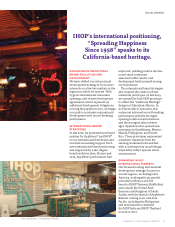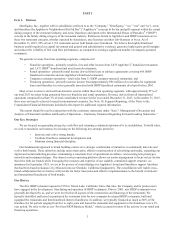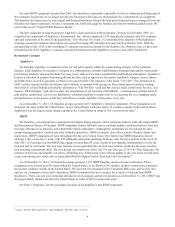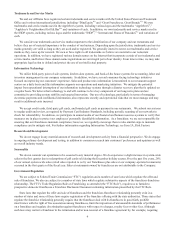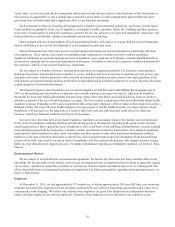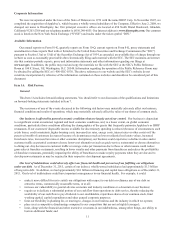IHOP 2015 Annual Report Download - page 23
Download and view the complete annual report
Please find page 23 of the 2015 IHOP annual report below. You can navigate through the pages in the report by either clicking on the pages listed below, or by using the keyword search tool below to find specific information within the annual report.3
PART I
Item 1. Business
DineEquity, Inc., together with its subsidiaries (referred to as the “Company,” “DineEquity,” “we,” “our” and “us”), owns
and franchises the Applebee's Neighborhood Grill & Bar® (“Applebee's”) concept in the bar and grill segment within the casual
dining category of the restaurant industry, and owns, franchises and operates the International House of Pancakes® (“IHOP”)
concept in the family dining category of the restaurant industry. References herein to Applebee's and IHOP restaurants are to
these two restaurant concepts, whether operated by franchisees, area licensees and their sub-licensees or by us. As of
December 31, 2015, 99% of our 3,716 restaurants across both brands were franchised. We believe this highly franchised
business model requires less capital investment and general and administrative overhead, generates higher gross profit margins
and reduces the volatility of free cash flow performance, as compared to owning a significant number of company-operated
restaurants.
We generate revenue from four operating segments, comprised of:
• Franchise operations - primarily royalties, fees and other income from 2,033 Applebee’s® franchised restaurants
and 1,672 IHOP® franchised and area licensed restaurants;
• Rental operations - primarily rental income derived from lease or sublease agreements covering 696 IHOP
franchised restaurants and one Applebee’s franchised restaurant;
• Company restaurant operations - retail sales from 11 IHOP company-operated restaurants; and
• Financing operations - primarily interest income from approximately $96 million of receivables for equipment
leases and franchise fee notes generally associated with IHOP franchised restaurants developed before 2003.
Most of our revenue is derived from domestic sources within these four operating segments, with approximately 91% of
our total 2015 revenues being generated from our franchise and rental operations. Revenue derived from all international
operations comprised less than 3% of total consolidated revenue for the year ended December 31, 2015. At December 31, 2015,
there were no long-lived assets located in international countries. See Note 18, Segment Reporting, of the Notes to the
Consolidated Financial Statements included in this report for additional segment information.
This report should be read in conjunction with the cautionary statements under “Item 7. Management's Discussion and
Analysis of Financial Condition and Results of Operations - Cautionary Statement Regarding Forward-Looking Statements.”
Our Key Strategies
We are focused on generating strong free cash flow and returning a substantial portion of it to stockholders. To build value,
we seek to maximize our business by focusing on the following key strategic priorities:
• Innovate and evolve strong brands;
• Facilitate franchisee restaurant development; and
• Maintain strong financial discipline.
Our fundamental approach to brand building centers on a strategic combination of initiatives to continually innovate and
evolve both brands. These initiatives include menu innovation, effective maximization of advertising and media, expanding our
digital and social marketing presence, maintaining a consistent level of operational excellence, and creating new prototypes,
remodels and restaurant designs. Our shared services operating platform allows our senior management to focus on key factors
that drive both our brands while leveraging the resources and expertise of our scalable, centralized support structure. As
announced in September 2015, we are in the process of consolidating core Applebee's brand and franchisee support functions
that had been based in Kansas City, Missouri into our Glendale, California headquarters. The consolidation will enable cross-
brand collaboration that we believe will provide for faster innovation and effective implementation to the benefit of domestic
and international franchisees of both brands.
Our History
The first IHOP restaurant opened in 1958 in Toluca Lake, California. Since that time, the Company and its predecessors
have engaged in the development, franchising and operation of IHOP restaurants. Prior to 2003, new IHOP restaurants were
generally developed by us, and we were involved in all aspects of the construction and financing of the restaurants. We
typically identified and leased or purchased the restaurant sites for new company-developed IHOP restaurants, built and
equipped the restaurants and then franchised them to franchisees. In addition, we typically financed as much as 80% of the
franchise fee for periods ranging from five to eight years and leased the restaurant and equipment to the franchisee over a 25-
year period. We refer to this as our “Previous IHOP Business Model,” which accounts for most of the activity in our rental and
financing operations.




